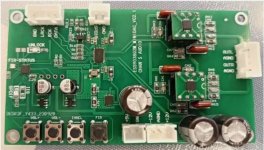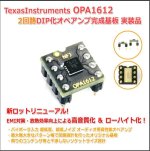OK, apologies if this has been detailed out elsewhere, but cannot determine proper direction.
I have been playing around with a cheap ES9038Q2M based DAC board that has dual opamp outputs (OPA1612 - possibly fake?). Stock it sounds very good (once you are able to correct the polarity out issue - no longer being sold on ebay as they have been recalled).
Anyway, I would prefer Balanced out to my balanced amps.
I have a few transformers...
JT-11-EMCF (600:600)
Sescom MI-52 (400/400:50k)
Sescom MI-8 (150/600:600)
Sescom MI-14 (150/600: 150/600 & 150/600)
Also have DRV-135 PCB that will also convert Unbal to Bal. Plan is to just pull the OPAMPs and take the ES9038 +/- out right off the OPAMP socket to transformer primary or input to DRV-135 for now.
Questions:
#1 - Which transformer would work best for Bal out? I have read that the ES9038 is a current out DAC, so 1:1 may not be ideal? See attached
#2 - Transformer or DRV-135 conversion - are either of these able to output Bal and Unbal Simultaneously?
Appreciate the advice!
I have been playing around with a cheap ES9038Q2M based DAC board that has dual opamp outputs (OPA1612 - possibly fake?). Stock it sounds very good (once you are able to correct the polarity out issue - no longer being sold on ebay as they have been recalled).
Anyway, I would prefer Balanced out to my balanced amps.
I have a few transformers...
JT-11-EMCF (600:600)
Sescom MI-52 (400/400:50k)
Sescom MI-8 (150/600:600)
Sescom MI-14 (150/600: 150/600 & 150/600)
Also have DRV-135 PCB that will also convert Unbal to Bal. Plan is to just pull the OPAMPs and take the ES9038 +/- out right off the OPAMP socket to transformer primary or input to DRV-135 for now.
Questions:
#1 - Which transformer would work best for Bal out? I have read that the ES9038 is a current out DAC, so 1:1 may not be ideal? See attached
#2 - Transformer or DRV-135 conversion - are either of these able to output Bal and Unbal Simultaneously?
Appreciate the advice!
Attachments
Last edited:
Everyone has one 🙂
I use 1:1 600 ohm line transformers after the opamps when using a ES9038Q2M device. Works better than without them. The schematic you attached says it is possible to connect transformers directly to ES9038 but I doubted that so I used the opamps. With AK4493SEQ I use Haufe ST-7679-1 1:1 600 Ohm transformers directly on the DACs output pins and the outputs of the transformers directly to XLR connectors with very good results except a very slight hum when no song is playing which I still need to solve. Likely parallel load resistors are really needed.
Maybe it is not the best idea to use XLR and RCA output simultaneously. Why would you?
BTW transformers seem simple but rest assured you can have a headache from thinking when wanting to implement them right with today's DAC chips. Also make sure there is no DC between their pins and that they are able to cope with the signal levels. With surplus studio stuff and unknown proprietary part numbers/parameters the larger they are the better they are for the task. Trial and error and measuring with a signal generator and oscilloscope helps. They are unfamiliar to many DIYers, you are on your own except when using stuff that has already been tried out, measured and tested.
I use 1:1 600 ohm line transformers after the opamps when using a ES9038Q2M device. Works better than without them. The schematic you attached says it is possible to connect transformers directly to ES9038 but I doubted that so I used the opamps. With AK4493SEQ I use Haufe ST-7679-1 1:1 600 Ohm transformers directly on the DACs output pins and the outputs of the transformers directly to XLR connectors with very good results except a very slight hum when no song is playing which I still need to solve. Likely parallel load resistors are really needed.
Maybe it is not the best idea to use XLR and RCA output simultaneously. Why would you?
BTW transformers seem simple but rest assured you can have a headache from thinking when wanting to implement them right with today's DAC chips. Also make sure there is no DC between their pins and that they are able to cope with the signal levels. With surplus studio stuff and unknown proprietary part numbers/parameters the larger they are the better they are for the task. Trial and error and measuring with a signal generator and oscilloscope helps. They are unfamiliar to many DIYers, you are on your own except when using stuff that has already been tried out, measured and tested.
Last edited:
General tips:
* always first measure DC offset (or use large value coupling caps). Testing and measuring preferably always with a large value cap in series. They hate DC.
** don't measure continuity with a DMM in resistance mode.
*** Solder them just once so test with crocodile clips. Some have such thin wiring that it melts internally when soldering too much (Neutrik NTL-1).
**** grounding correctly and metal casings now suddenly have extra importance, you'll likely notice that.
They are fun to try out and listen to.
* always first measure DC offset (or use large value coupling caps). Testing and measuring preferably always with a large value cap in series. They hate DC.
** don't measure continuity with a DMM in resistance mode.
*** Solder them just once so test with crocodile clips. Some have such thin wiring that it melts internally when soldering too much (Neutrik NTL-1).
**** grounding correctly and metal casings now suddenly have extra importance, you'll likely notice that.
They are fun to try out and listen to.
Last edited:
I have read that the ES9038 is a current out DAC,
This depends on the load - at high load it is the voltage output, at low load it is the current output.
In fact, it is a voltage source, DC biased and with a series resistor at the output.
Since I was advised on adding the transformer after the stock Opamp, I just wired the "abandoned" negative side of the opamp out to pin 3 of the XLR.
Sounds great and did not have to add another component...... is this a bad idea? DAC now has Balanced out to Balanced amps.
As far as the stock OPA1612 Opamps - don't know if they are fake, but replaced them with a LM4562...
The price of a OPA1612 from Digikey is around $7- $8, and the whole DAC Board was only $35 shipped...don't know how they can make any money selling these DAC boards....
Sounds great and did not have to add another component...... is this a bad idea? DAC now has Balanced out to Balanced amps.
As far as the stock OPA1612 Opamps - don't know if they are fake, but replaced them with a LM4562...
The price of a OPA1612 from Digikey is around $7- $8, and the whole DAC Board was only $35 shipped...don't know how they can make any money selling these DAC boards....
Attachments
An original OPA1612 would seem more appropriate as LM4562 quality is dependent of batch. Probably solved but still. The OPA1612 delivered with it maybe IS an original. No offset worth mentioning?!
ES9038Q2M is nothing special whatever the reason may be. Instead of upper class it more seems the standard IC in cheap devices and it sounds accordingly. But ....with the opamp/transformer config it sounds way better. Maybe my stuff does not register what is happening as I see no difference but it can be heard clearly. In my case the transformers are used on the balanced output via XLR so externally to gains balanced XLR at the secondary side.
They probably make money by using recycled parts together with an original ES9039Q2M. Board layout is nothing to write home about but if it sounds to your likings all is well.
ES9038Q2M is nothing special whatever the reason may be. Instead of upper class it more seems the standard IC in cheap devices and it sounds accordingly. But ....with the opamp/transformer config it sounds way better. Maybe my stuff does not register what is happening as I see no difference but it can be heard clearly. In my case the transformers are used on the balanced output via XLR so externally to gains balanced XLR at the secondary side.
They probably make money by using recycled parts together with an original ES9039Q2M. Board layout is nothing to write home about but if it sounds to your likings all is well.
Last edited:
OK, this is odd...I just cleaned off the OPA1612 opamps that came with DAC to take a closer look at the chip - one of the two was now visible:
OVII
TI521
CK8T
Searching the internet, I see a Japanese website selling OPA1612 that reads similar... (TI541)
https://store.shopping.yahoo.co.jp/nfj/o524.html
It does not say OPA1612 like others seen on internet..... anyone have an idea if real?
A Texas Instruments OPA521 is a Line driver, so pretty sure its not an OPA521...
In meantime, I will leave the LM4562 in...
OVII
TI521
CK8T
Searching the internet, I see a Japanese website selling OPA1612 that reads similar... (TI541)
https://store.shopping.yahoo.co.jp/nfj/o524.html
It does not say OPA1612 like others seen on internet..... anyone have an idea if real?
A Texas Instruments OPA521 is a Line driver, so pretty sure its not an OPA521...
In meantime, I will leave the LM4562 in...
Attachments
Last edited:
OPA1612 SON package has device marking OVII but your OPA1612 could still be a fake. Without measurements it is impossible to tell.
Thank you for that info!
Other than price, I have no other indication of legitimacy. I will check the DC offset on both the OPA1612 and the LM4562....as recommended by Jean-Paul...
EDIT - Just checked DC offset wrt ground pin with Fluke 77
OPA1612 was 1mv (highest) and .5mv (lowest)
LM4562 was .5mv (highest) and 0mv (lowest)
EDIT EDIT - whoops, looks like jean-paul was recommending checking DC offset on Transformers, not opamps...oh well...
Other than price, I have no other indication of legitimacy. I will check the DC offset on both the OPA1612 and the LM4562....as recommended by Jean-Paul...
EDIT - Just checked DC offset wrt ground pin with Fluke 77
OPA1612 was 1mv (highest) and .5mv (lowest)
LM4562 was .5mv (highest) and 0mv (lowest)
EDIT EDIT - whoops, looks like jean-paul was recommending checking DC offset on Transformers, not opamps...oh well...
Last edited:
No one should measure DC offset before doing anything with line transformers.
The outputs of the opamps are connected to the transformers I think 😉. 0,5 ... 1 mV between the transformer pins is no problem.
The outputs of the opamps are connected to the transformers I think 😉. 0,5 ... 1 mV between the transformer pins is no problem.
Last edited:
- Home
- Source & Line
- Digital Source
- ES9038Q2M Transformer Output Questions



